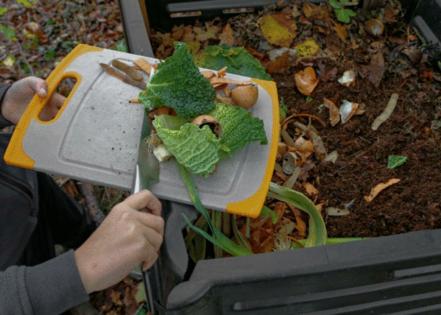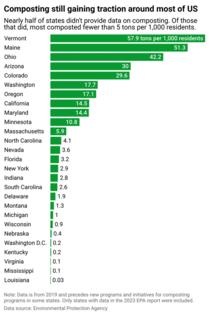Just 5% of America's food waste is composted. Which states are getting it done?
Published in Slideshow World
Subscribe
Just 5% of America's food waste is composted. Which states are getting it done?
Americans composted about 3.3 million tons of food waste in 2019, according to the Environmental Protection Agency's most recent estimates.
That may seem like a lot, but consider that between residential areas, commercial food service, and food retail, Americans generated 66.2 million tons of wasted food in the same year. That means about 5% of the nation's food waste is composted, with the rest ending up in landfills, where food is the most commonly found material. In landfills, food waste decomposes much slower than when composted. Lacking oxygen, it also produces methane, a harmful greenhouse gas.
While these statistics are grim from a sustainability standpoint, they do convey an opportunity for new composting companies and systems to arise.
To find where there is an appetite for composting and where composting infrastructure may be lacking, Machinery Partner mapped the quantity of compost per capita in each state using data collected by the Environmental Protection Agency. The data was released in 2023 but represents 2019, so it precedes new programs and initiatives for composting programs in some states.
Composting is a natural recycling process in which insects, bacteria, and fungi break down yard waste and food scraps, returning their nutrients to the soil and providing for new plant life. Composting reduces greenhouse gas emissions, replenishes organic materials in soil, creates jobs, and reduces costs for traditional garbage and landfill management.
In practice, composting can take many different forms, from burying food scraps in the backyard to municipal and commercial services that pick up compost and yard waste bins and take them to processing facilities similar to other U.S. trash collection systems.
A BioCycle study identified over 200 full-scale composting facilities in the U.S., of which the vast majority were privately owned or operated. The organics recycling publication also found that there was a 49% increase in the number of households with access to residential food waste collection programs between 2021 and 2023, though these services reach just 12% of homes. The presence of backyard composting and small community sites is much harder to quantify.
In January, the Department of Agriculture announced a $11.5 million investment into composting and food waste diversion programs across 23 states through the American Rescue Plan Act of 2021. In a continuation of this effort, the USDA is in the process of selecting two-year pilot projects for composting and food waste reduction to support, largely from local and tribal governments and organizations, which would launch in 2025. These funds build on over $12 million in similar investments since 2020.
Visit thestacker.com for similar lists and stories.
Few states commit to composting in earnest as of 2019
States like Vermont, Maine, and Ohio already had relatively robust composting programs as of 2019, the EPA data shows. Vermont fully mandated composting starting in 2020, banning food scraps from landfills. As the state built up to that ban over the past decade-plus, composting facilities and private food waste collection services popped up across the state to fill the need. By mid-2020, the small state had over 100 transfer stations offering food scrap collection, with a mandate that every trash collection facility also process food scraps.
Ohio, already a high-ranking state, is the site of further compost program expansions. The city of Cleveland was among the recipients of this year's agriculture department investments, receiving funding for a program to increase access to composting services and to subsidize those services for SNAP recipients.
The more recent BioCycle study found that about 50% of U.S. full-scale food waste composting facilities were located in seven states: California, New York, Colorado, Pennsylvania, Washington, Texas, and North Carolina. Residential collection services were most prevalent in the West and Northeast, though some were available in states interspersed throughout other regions. The highest volume of programs was found in California, Illinois, New York, and Minnesota. This limited coverage implies a vast population of would-be composters and many opportunities for new private and municipal services.
Some low-ranked states were recipients of federal dollars in recent years. Virginia, which reported composting just 200 pounds per 1,000 residents in 2019, has received over $475,000 since 2020 toward four different composting and food waste reduction projects, according to the USDA. These projects aim to expand compost through curbside pickup and community drop-off sites. They also establish composting programs at major sites like the Virginia Zoo, Norfolk, and in K-12 schools.
Many states lacked data for the EPA composting report. In some sectors and regions, this data simply hasn't been collected historically, while in others, data updates are few and far between. This includes New Mexico, which has only released recycling and diversion data through 2015 on a Diverting from Landfills state website and which does not separate out composting. According to its most recent data, New Mexico has a 16% recycling rate, compared to the 32% rate nationwide. A recycling coalition in the state touts that expanding recycling and composting within the state has the potential to add thousands of local jobs.
At least one project in New Mexico was included in the USDA's most recent compost funding distributions. It will support community compost co-ops and farm compost hubs in parts of Albuquerque that don't have access to private composting services.
With access to continued public investments, savings opportunities, and awareness of the environmental impact, states across the country are expanding composting infrastructure. In 2015, the EPA and USDA planned to cut food loss and waste in half by 2030—reducing waste from 328 pounds per person per year to 164 pounds. By 2019, the country had achieved a 6% increase from the original baseline, meaning there's substantially more work to come.
Considering this, there are evermore opportunities for individuals to learn about and advocate for composting in their communities and for prospective or existing businesses to fill the growing demand for composting services across the country.
Story editing by Mary Reardon. Additional editing by Kelly Glass and Elisa Huang. Copy editing by Tim Bruns.
This story originally appeared on Machinery Partner and was produced and distributed in partnership with Stacker Studio.








Comments